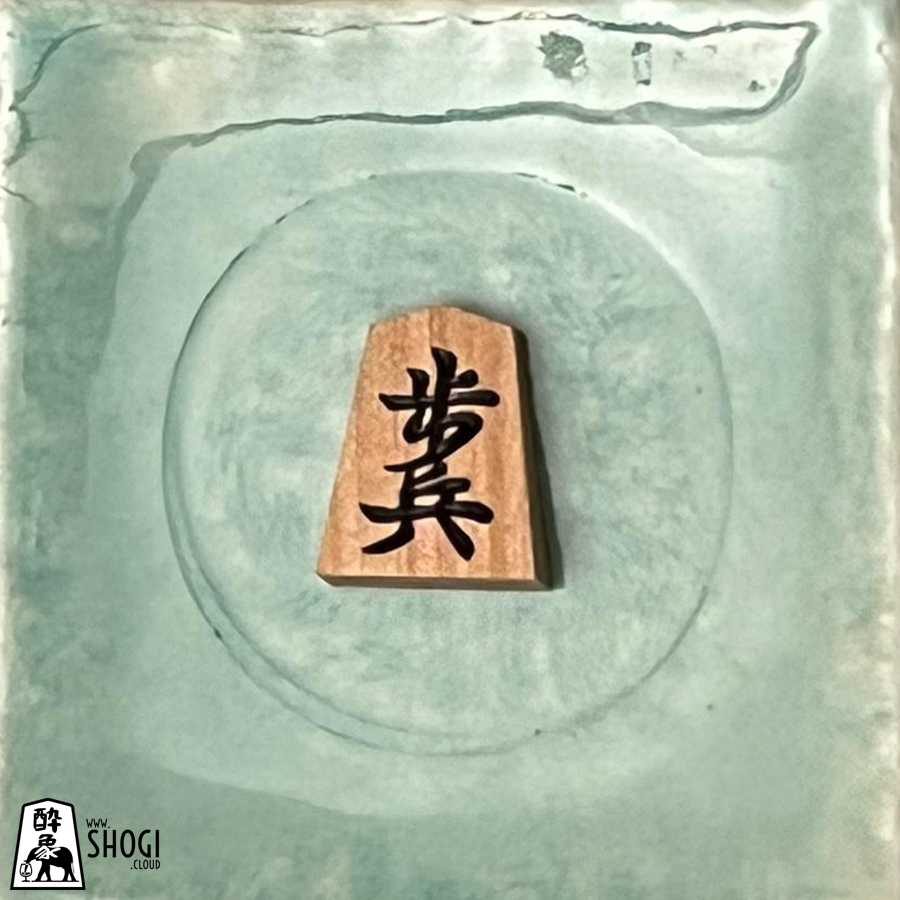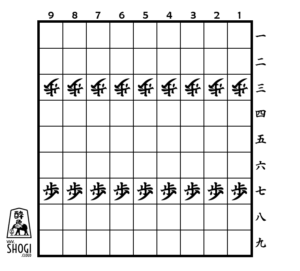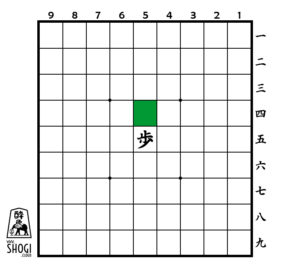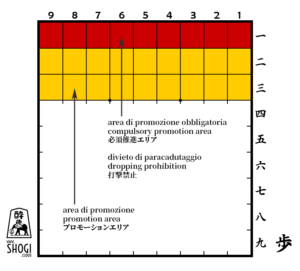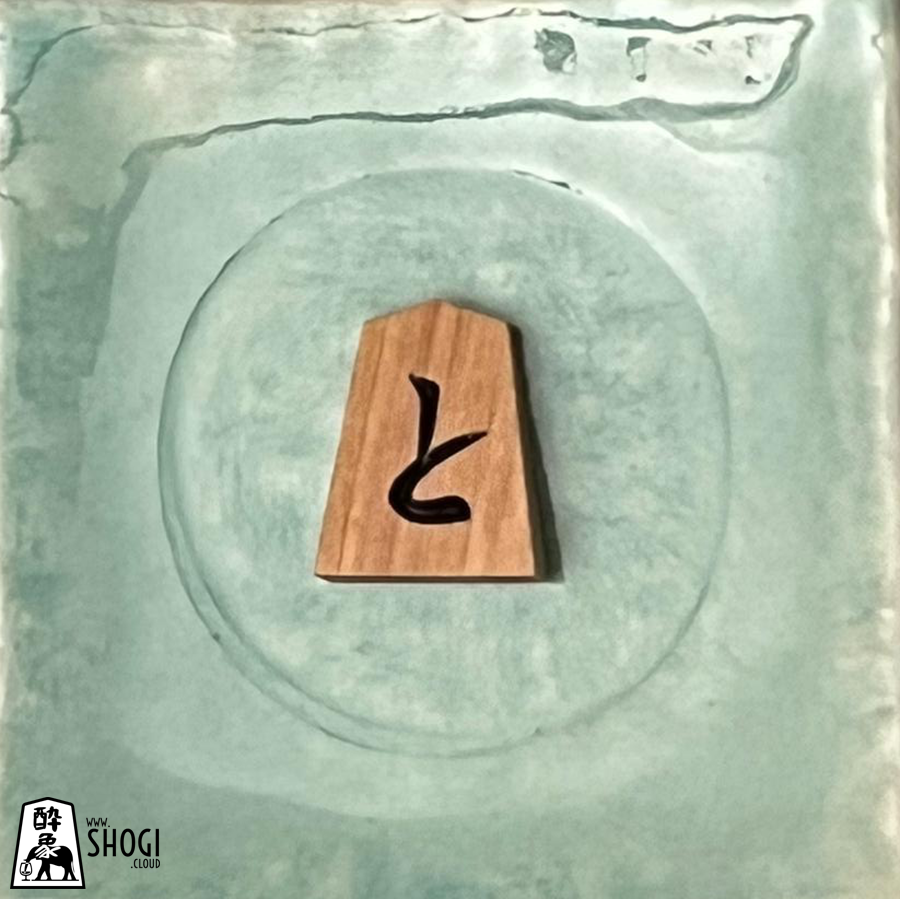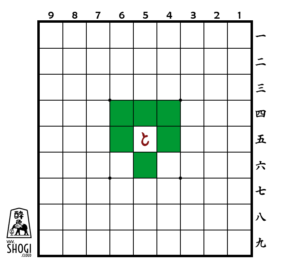english
Abstract
The Fuhyō (歩兵) is the most numerous and fundamental piece in Shogi (将棋), with simple movements but a crucial strategic role, especially when promoted to Tokin (と金).
The specific rules concerning it add tactical depth to the game.
Its name, derived from the kanji “walk” and “soldier,” signifies its function as infantry in the game.
english
Fuhyō (歩兵) in Shogi (将棋)
The Fuhyō (歩兵), translated as a pawn, is fundamental in the game of Shogi (将棋), often compared to the pawn in Western chess. It is the most numerous piece available to players.
Historically, the Fuhyō (歩兵) has always played a crucial role in ancient variants of Shogi (将棋) such as Chū shōgi and Dai shōgi.
The Fuhyō (歩兵) moves one square forward and cannot retreat. When it reaches the third-to-last or second-to-last row of the opponent’s camp, it may be promoted to Tokin (と金), gaining movements similar to those of the Kinshō (金将), known as the Gold General. When it reaches the last row of the opponent’s camp, promotion to Tokin (と金) becomes mandatory.
Fuhyō (歩兵) are essential for opening attack lines and defending within Gakoi (囲い), translated as Castles. Their promotion to Tokin (と金) represents a significant threat, as the Tokin (と金) combines the mobility of the Kinshō (金将) with an advanced position. Dropping (Utsu – うつ) one or more Fuhyō (歩兵) creates important aggressive tactics to force the opponent into constrained movements.
A unique rule in Shogi (将棋) is the prohibition of “Nifu” (二歩), which prevents having two unpromoted Fuhyō (歩兵) in the same column. Additionally, using a newly introduced Fuhyō to deliver an immediate checkmate is prohibited, known as “Uchifudzume” (打ち歩詰め). Importantly, breaking these rules results in an automatic loss.
The term Fuhyō (歩兵) consists of two kanji (漢字):
“歩” (fu) → means “to walk” or “step.”
“兵” (hyō) → means “soldier” or “troop.”
Together, “walking soldier” signifies the role of the pawn as infantry on the Shogi (将棋) battlefield.
Notably, the same term 歩兵 can also be read as ほへい (hohei or hohē), which in Japanese means “infantry” or “foot soldier” in a military context.
The pronunciation Fuhyō (歩兵) is a specialized Shogi (将棋) term, likely adopted to distinguish it from the common meaning of hohei – hohē. This variation is an example of homography in the Japanese language, where words with the same kanji can have different readings based on the context.
Notes
Chū shōgi (中将棋): an ancient variant of Shogi (将棋) played on a 12×12 board, characterized by a greater number of pieces and more complex movements.
Dai shōgi (大将棋): an even larger version, played on a 15×15 board, containing special pieces and advanced rules.
english
Abstract
The Tokin (と金) is the promoted form of the Fuhyō (歩兵) in Shogi (将棋), gaining the movement abilities of the Kinshō (金将). This promotion significantly increases the “strength” of the koma (駒), making it highly important in tactical play. The representation of the Tokin with the character “と” emphasizes its connection to the concept of “gold” in the game.
english
Tokin (と金) in Shogi (将棋)
The Tokin (と金) is the promoted version of the Fuhyō (歩兵), the Pawn in Shogi (将棋). Once promoted, the Tokin (と金) can move to six adjacent squares, significantly increasing its control over the Shogiban (将棋盤).
The promotion of pieces, koma (駒), including that from Fuhyō (歩兵) to Tokin (と金), is a distinctive feature of Shogi. Almost all koma (駒), except for the Kings (Ōshō 王将, Gyokushō 玉将) and Gold Generals (Kinshō 金将), can be promoted, gaining additional movement options and greater control.
The Fuhyō (歩兵) moves one square forward and cannot retreat. When it reaches one of the last three ranks of the opponent’s camp, it may or must be promoted to Tokin (と金). The Tokin moves like a Kinshō (金将), the Gold General, namely:
One square forward, backward, left, or right.
One square diagonally forward to the left or right, but it cannot move diagonally backward.
The promotion of the Fuhyō (歩兵) to Tokin (と金) is crucial in Shogi tactics. A Tokin (と金) controls six adjacent squares compared to the single square of the Fuhyō (歩兵), and if captured, the opponent only gains a Fuhyō (歩兵). The promotion and sacrifice mechanism is highly advantageous. Since it can only retreat one square and cannot be dropped back onto the board, it rarely plays a defensive role except in specific situations.
The term Tokin (と金) means “reaches gold,” indicating the acquisition of the abilities of the Gold General (Kinshō 金将) through promotion. The promotion of the Fuhyō (歩兵) to Tokin (と金) is performed by flipping the piece (koma 駒), revealing the hiragana character “と” (to), part of the Japanese phonetic syllabary.
The character “と” used to represent the Tokin (と金) is a simplification derived from the kanji for “gold” (金). This choice reflects the direct connection between the Tokin (と金) and the Kinshō (金将), as the promoted piece gains the same abilities as the Gold General.

